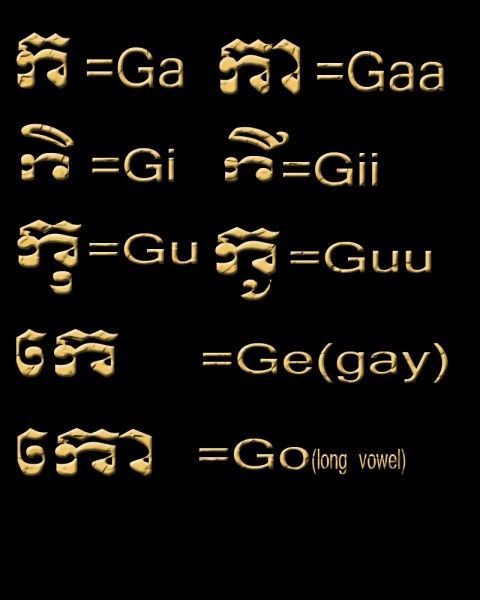How to read and write Khom (Khmer Sanskrit) – Essential studies for students of Sak Yant and Thai Sacred Geometry
Sak Yant Foundation Project Khom School Video Tutorials, presents the second lesson. To show how to combine writing Vowels with Consonants, this video demonstrates how to write the letter G (Ga) with the Vowel I (Gi) in both long and short Vowel forms (Gi and Gii). The first lesson showed how to write Ga and Gaa, this one shows Gi and Gii.
There are Eight pure Vowel sounds, with some extra vowels, which add up to maken 12 in all
A, Aa, I, Ii, U, Uu, Ae and O (pure Vowels), + Ang Ing Ung and Aw (pronounced ‘or’). ‘Ang Ing Ung and Aw’ are written using the a i and u vowels with a small circle written above the Consonant or Vowel, which produces an ‘NG’ sound at the end. A + ํ = Ang
In this Video we only need to focus on the letters G and I to combine them. The video begins at the end of lesson 1 which showed how to combine G + Aa, teaching to write the sounds ‘Ga’ and ‘Gaa’, and moves on to demonstrate how to write ‘Gi, and Gii’
The Below Image May assist in Understanding how vowels are written not only to the right of a Consonant, but some vowels are written below, left, or above the preceding consonant. The first letter ga, is a simple G, NOT a G+A! The short ‘A’ vowel does not need to be written for consonants with short vowels, because the short ‘A’ vowel is automatically included with each consonant. So when we write ‘Ga’ (short A) in Khom, we simply write ‘G’, and that means ‘GA’. There is a separate character for short ‘A’ vowel for cases when you wish to write the letter ‘A’ as a short vowel without a preceding Consonant or character. This will be explained in a later lesson. Memorize the first character ‘Ga’ as the G letter, and then scrutinize the various vowels that are attached to the Ga in the images that come after it.
If you are observant, you will notice the Gi and Gii look different to the other words. This is because the I vowel is written above the Consonant (in this case a G) .
In the case of consonants which have the ‘W shaped roof’ (the topmost horizontal zig-zag line on the top of the G character), as does the G, the roof is removed and the I vowel replaces it. If you examine the Character without the I vowel you will see it is the bottom half of the G character with the top half removed. This happens with all Consonants that have this ‘double v roof’ on them (there are quite a few in the alphabet like this), when using the I vowel to write above the Consonant.
The next Video shows how to write ‘Go’ using the ‘Ae’ (as in ‘Way’) vowel and the Aa vowel together to form a Compound Vowel and a new sound ‘O’.
